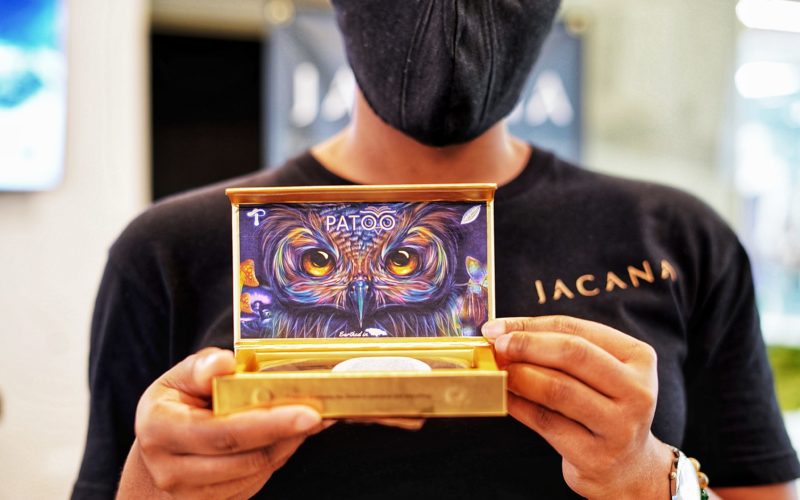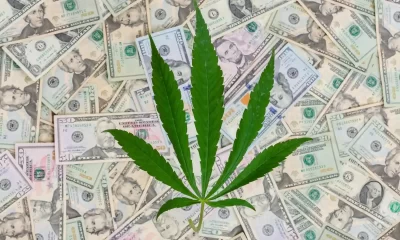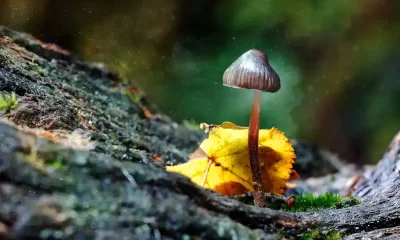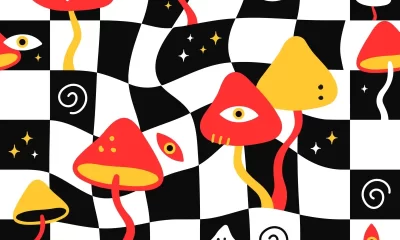Blogs
The Great Jamaican Patoo Trip

Experiencing the first legal Jamaican psilocybin mushroom product line, Patoo, at the resurgence of Negril post-COVID.
The World Health Organization (WHO), recently citing one of their fresh, dark-timeline COVID-19 pandemic stats, alerted the world that there’s been a shocking/not-shocking 25% increase in prevalence of anxiety and depression in adults across the world. A number which, frankly, begins to feel light when taking into context the various ugly aspects of these increasingly dystopian times.
Adults are hardly in solo sad company. Data from a youth charity The Prince’s Trust, says 23% of young people in the U.K. claim they are seeking psychedelic experiences and will “never emotionally recover from the emotional impact of the pandemic.” Existence itself, it seems, is more a burden emotionally than ever before.
Kevin Bourke agrees: “Global mental health has deteriorated and people need perspective and balance.” Bourke, co-founder of Patoo—Jamaica’s first legal psychedelic CPG line of psilocybin products—has a particularly astute vantage point to witness both the trending explosive interest and use of psychedelics as well as the return of tourism culture on his home turf after the devastation of COVID on the travel industry at large.
Particularly hard hit were places like the island’s longtime beach and cliff-lined bohemian playground of Negril in the West End, where I caught up with him in the spring of 2022 while on the island for my own physical and spiritual recharging of sorts. Patoo is quickly gaining traction around the island with dozens of retail partners all across Jamaica carrying their products, from legal cannabis dispensaries like Jacana, through to locally infamous mushroom cafes, weed huts, right up to posh resorts like Skylark along the beach, or Rockhouse in the cliffs, where Patoo is also hosting “Psilocybin Soundbath” experiences for guests.

In the gift shops, the eye-catching Patoo packaging is right at home alongside tanning oils and sun hats. Think: gluten-free, direct trade and locally-farmed dark chocolate bars, dosed Jamaican honey, microdosed mushroom capsules, and more strain-based products being developed with Patoo’s R+D team.
“The vibe in Negril and the whole island is bringing people seeking experiential tourism and wellness after COVID, and the Caribbean has bounced back. It’s the perfect time for Jamaica to step up in this realm and be a leader for adults seeking these products,” says Bourke.
Patoo’s other co-founder Charles Lazarus, a twenty-year veteran of touring roots-reggae band Rootz Underground Movement says: “We didn’t come up with mushroom-dosed chocolate, they just go well together in nature, and both are medicine,” he says. “The dark chocolate provides oxytocin, the love transmitter, and then you have the Jamaican mushrooms with a very expansive personality.”
A Jamaican owl—Patoo—greets you as the brand mascot and spiritual talisman to the public, and as a brand the team says they seek to be a bridge builder between the natural world, research, and commerce. Besides partnering with island farmers for all-local chocolate and a greater harmony with their proprietary indigenious hybrid genetics, their main Patoo 4-gram dark chocolate bar uses a wild Jamaican strain they cross-cultivated the mycelium with in order to be consistent and shelf-stable. It also allows them to tightly and accurately control even-dosing across the product (read: you can anticipate the effects for a better experience). And yet, their biggest cost is the Jamaican cacao, which is regarded as one of the best on the planet.
In an even more impressive move, Bourke, along with Lazarus and their team worked to execute the first legal shipment of Jamaican psilocybin using native genetics cultivated by the Patoo team to the University of Alberta and Health Canada for research on PTSD in the Canadian Military.
That image of psychedelics as both therapy and a fun time for responsible adults is changing, if the ongoing legalization movement is any indicator. The FDA has proclaimed psilocybin to be a “breakthrough medicine” and that perspective is increasingly being found at the end of a micro or macro dose of plant-based psychedelics like magic mushrooms. While on the island for my own restorative trip to Negril, I too wanted to sample the indigenious and proprietary genetics unique to Jamaica.

In the case of Patoo, they offer a means to try mushrooms naturally harvested in controlled environments—knowing the diet of the cows producing the substrate growing manure to ensure the integrity of the mycelium, as well as the metabolites, which influence and direct the effects the way terpenes interact with cannabinoids in cannabis.
With all that in mind, it’s no surprise to find accessibility and professional, safe psilocybin products being at the forefront of the experiential tourism trend that is growing in Negril, and greater Jamaica. Legality means greater diversity and standards of CPG goods, in psychedelics just as it did with weed. “[Psychedelics] are moving extremely fast, it feels different than cannabis,” says Lazarus. “Cannabis definitely led the path and highlighted the right way, also the wrong ways, of progressing an industry like this. Psilocybin will challenge the wine and spirits space in ten years.”
As a brand, Patoo is already creating a buzz on social media as an easy and reliably-dosed access point to the island’s psychedelic mushroom culture, which already has been strong for years. But Bourke brings a different element of connectivity and understanding the market. A seasoned branding creative, he helped create Blackwell Rum with his mentor Chris Blackwell (English-born founder of Island Records and the first person to put reggae music out on a pro label), worked with Usain Bolt’s Tracks & Records restaurant brand, and is the co-founder of the music and wellness cultural festival TmrwTday.
In other words, he was the choice of choices to connect me and be my guide to Patoo. I was staying at Tensing Pen, a small independent resort in the cliffs that is what I’d like to think resides in the afterlife for people who love dogs (they have a few Rhodesian Ridgebacks that roam the area). Having grown up hanging out in Negril, Bourke effortlessly manifested at the table my girlfriend and I were at, adjusting to the island vibes after the flight in from Boston. I was supplied with some gratis Social Dose bars (.7g of locally grown Hawaiian cubensis) and the flagship Patoo Bar, dosed with 4g their proprietary Jamaican Cyanescens strain crossed with APE (Albino Penis Envy).
Each Patoo bar has three squares to it, each dosed at 1.33g. One square, Bourke said, and “it’s dancing time”. Two and we get into fractals and visual distortion and a sense of being connected. Three, and he said “it’s time to chill out and have a friend nearby because you going on a journey”. I had already had one big journey that day, I was just looking for the lift.
I also just decided to eat a full Social dose after that long day of travel and a few months between psilocybin consumption. Scene and setting was set. Hadn’t even begun the four days on, three days off regiment suggested by psychonauts for your brain and system to reset (and deal with increased tolerance). The effect of the whole bar left me like I’d been hit upside the head by a wet rowing oar (I hadn’t had a full meal yet, violating one of Patoo’s suggestions for consumption).

After I adjusted a bit on the frantic energy and overwhelming sensations, I slid into a great pocket of euphoria and social connectedness to everything around me, but I was never out of range or uncomfortable in my surroundings (nothing gets you weirder than putting your hand through your phone while going to change up your playlist). It was also robust in earthy mushroom flavor.
The dogs and my girlfriend at sunset. The saltfish at the restaurant overlooking the moonrise. The cove at Tensing Pen, smashed by ancient waves on old pirate coral. The restoration to my body and mixing with local ganja consumed in great quantities from both the local dispensary circuit (Jacana) and some local farmers as well. Helluva first day.
The next evening I dove into a 1.33g square while cruising the long beachfront road down from the cliffs, with drums of jerk chicken being smoked along the way and the party looked like it was outside the venue more than inside. Plenty of shady corners away from the streetlights and drum fires where typically one ducks into for the gamblers’ choice of local fungi. A dicey situation any way you slice it.
“If you buy mushrooms and don’t fully know the source, it can affect your mindset going in. And scene and setting is so key when experiencing psilocybin, and commercially it doesn’t make sense to create a product that gives people a negative episode,” says Bourke. “Charles and our team have worked out our consistency and dosing so we can approach this product as a CPG as well as a plant medicine. You can take some Patoo and then return to it a month later seeking that groove and those sensations (and knowing your limits), and find it’s repeatable. Dosage is huge for us and Patoo.”
That dosage was what I was relying on given the visual and auditory overload I was about to step into. Namely, the first Negril nighttime beach party where everyone comes in from the hills in Westmoreland and surrounding parishes to attend a massive DJ set of everything from the Beatles to traphouse beats, with locals dressed like they were heading to the club, only to be met with fire ants in front of the stage and lounge area that would beat back the surging crowd and leave an awkward negative space in the crowd… where I was standing.
Not wanting to be rude—and with all 1.33g surging through me—I enjoyed the evening with my new friends and executed four straight hours of dancing for a guy who doesn’t dance. Admittedly the fire ants would maul me the moment I stopped, and the dancing was the white-man’s two-step rocking back and forth and pounding water all night. All in all, the dosage for me was just right. And best of all, repeatable. The next night. And the afternoon after.
And then back home just as spring flipped into summer, after walking through the Ukrainian sculpture park I live near, alone on my back in the sun with my dog scurrying nearby and not a soul around.
“The paradigm has shifted and evolved and a whole generation is upset that they have been deceived, to their detriment, over the broken narrative around psychedelics as a therapeutic option,” says Lazarus. “With the attention in the press, the ground-swell around the holistic approach to life and a return to organic food, places of high energy and legal psilocybin medicine such as Jamaica have become a travel focus for people that are seeking inner healing,” says Lazarus. “We are proud of this offering to the world.”
Source: https://hightimes.com/culture/the-great-jamaican-patoo-trip/
Blogs
Border sales a boost for most marijuana retailers across US

Marijuana sales along state lines are key revenue generators for retail operators in the United States, and new insights suggest a similar business bump along international borders, particularly Mexico.
Data compiled by New York-based wholesale technology platform LeafLink – as well as information gathered from state agencies, quarterly reports and interviews with several cannabis companies – bear that out.
LeafLink analyzed hundreds of ZIP codes at the request of MJBizDaily and found strong links that when new recreational markets open, retailers near borders stock up on inventory significantly more than operators located elsewhere in a state.
Data from the past three years revealed wholesale marijuana products purchased by border stores jumped 140% after the launch of adult-use sales, while retailers located in more interior areas increased purchases by about 80%.
“The growth when a state launches adult-use sales at a border store in terms of purchasing activity is around double the growth of the remainder of the state,” LeafLink Strategy Analyst Ben Burstein told MJBizDaily.
Of course, numerous factors are at play – perhaps none more impactful than the marijuana policies of neighboring states.
That’s why Illinois retailers near Wisconsin, where marijuana possession is illegal, are still attracting Wisconsinites nearly four years after the launch of recreational sales.
There also are retail sales-tax implications, a big reason why St. Louis-areas operators are seeing an influx of shoppers from southern Illinois, where cannabis taxes are at least three times higher than in Missouri.
Meanwhile, border retail in New Mexico is boosting depressed economies along hundreds of miles of its shared borders, drawing stampedes of consumers from neighboring Texas and, more recently, cross-border buyers from Mexico.
Retail shakeup in the heartland
The February launch of adult-use sales in Missouri has caused ripple effects throughout the Midwest.
Missouri holds the rare distinction of bordering eight states, with only Illinois offering recreational marijuana sales.
Missouri’s 6% retail tax on recreational marijuana purchases is also among the lowest in the nation, drawing Illinois consumers across the Mississippi River in droves to buy much cheaper weed.
All in, cannabis sales taxes in neighboring Illinois eclipse 30%, second only to Washington state. And in Chicago, sales taxes can easily top 40%.
Demand is booming in western Missouri, too.
In April, Missouri retailers near the border of Kansas, where marijuana possession is also illegal, told MJBizDaily they were seeing foot traffic increase ninefold after expanding into recreational sales.
The rush of new customers, coupled with cultivation-capacity lags, has led to big spikes in wholesale flower prices and inventory shortages throughout the supply chain.
Retailers, for their part, are trying to keep pace.
To meet consumer demand, wholesale purchases per store in the Kansas City, Missouri, market increased from $97,000 in the quarter before the launch of recreational sales to $491,000 in the quarter after, a whopping 406% jump, according to LeafLink data.
In the St. Louis market, which borders southwestern Illinois, wholesale purchases per store increased nearly 57%, to $610,000, after adult-use sales began.
“The demand’s been bigger than anyone expected,” Burstein said.
A zero-sum game
In marijuana retail, particularly near state borders, it’s a zero-sum game.
The sales boom in the St. Louis market, which has more than 70 stores, has deflated business on the Illinois side of the border, where retailers have lost millions of dollars in sales since Missouri’s adult-use launch, according to quarterly reports and earnings calls.
Top executives at New York-based multistate operator Ascend Wellness Holdings, which has two shops near the Missouri border, cited revenue declines at its southern Illinois stores in recent earnings, saying it has led to suppressed margins that are expected to linger for much of the year.
Florida-based MSO Jushi Holdings, which also operates two Illinois stores near the Missouri border, reported an 8.8% year-over-year revenue decline to $66.4 million in its second quarter, partially attributing the slide to adult-use sales in Missouri.
In an Aug. 11 second-quarter earnings call, Jushi CEO James Cacioppo said total Illinois sales declined 20% from the first quarter and 40% year-over-year.
“I think we under-anticipated the pricing power initially out of the gate that retailers were going to have in Missouri,” Jushi Chief Strategy Director Trent Woloveck told MJBizDaily in an interview.
“The impact was a little bit greater than then we had thought due to that pricing for flower, vapes and infused products.”
In response, Jushi has implemented several initiatives, including adding new promotions and diversifying product SKUs (stock-keeping units) to ease the impact of declines sales in Illinois.
Northern exposure
Market dynamics in northern Illinois, particularly along the Wisconsin border, are a different story.
Wisconsin is among 10 states without a medical or recreational marijuana program.
Illinois counties bordering Wisconsin – including Lake, McHenry, Jo Daviess and Winnebago – accounted for 15.4%, or $239.7 million, of the nearly $1.6 billion in cannabis sales last year in the state, according to a fiscal analysis requested by pro marijuana-legalization lawmakers in Wisconsin.
The Wisconsin Legislative Fiscal Bureau report, which was released in March, cited annual statistics from the Illinois Department of Financial and Professional Regulation.
Moreover, the report estimated about 7.8% of marijuana sales in Illinois in 2022, roughly $36.1 million, were generated by out-of-state residents traveling from Wisconsin.
Under Illinois law, out-of-state residents can only purchase recreational cannabis.
Two of Chicago-based multistate operator Cresco Labs’ 10 stores in Illinois are located near the Wisconsin border: a Sunnyside outlet in South Beloit at the border and one in Rockford, about a 30-minute drive away.
The South Beloit store often draws up to 1,000 daily visitors, according to Cresco’s national retail president, Cory Rothschild – traffic on par with the nation’s busiest marijuana retailers in highly populated areas.
It’s all the more impressive, considering that South Beloit has a population of roughly 8,000 and is more than 40 miles from Madison, the nearest city and Wisconsin’s state capital.
“It’s an extremely high-volume retail location,” Rothschild told MJBizDaily.
“South Beloit and Rockford as well are probably (among the) top dispensaries in the country.”
Maryland
Maryland is the newest recreational cannabis market, with nearly 100 medical marijuana dispensaries having converted to adult-use retail in late June.
While LeafLink wholesale data suggests about a 10% increase in wholesale product purchases statewide after the launch of adult-use sales, some retailers along Maryland’s south and eastern borders are doubling orders to meet demand.
In Elkton, near the Delaware border, stores are ordering about $41,000 in wholesale products per month, up 115% since the launch of recreational sales on July 1.
In the Rockville/Germantown area – outside of Washington DC and near the Virginia and West Virginia borders – monthly wholesale purchases have increased about 42%, to $54,000 per store, since recreational sales began.
Though MMJ dispensaries opened in West Virginia in 2021, the state still has some of the harshest marijuana laws in the country, according to the Marijuana Policy Project.
Meanwhile, Virginia’s adult-use rollout has been put on ice by Republican Gov. Glenn Youngkin.
MSO MariMed’s wholesale business serving retailers in Maryland has benefited from increased demand from neighboring states, according to Jeff Jones, director of operations.
“We have retail customers that are very close to Virginia, Pennsylvania and West Virginia, and I’m sure that’s driving a significant amount of their business,” he said.
The Massachusetts-based company supplies every retailer in the state with its product brands.
MariMed is planning to double its cultivation and canopy space in Maryland, with product from that expansion expected to hit the wholesale and retail markets in the first quarter of 2024, Jones said.
Its retail operation in Annapolis – the state capital is about a 45-minute drive from Pennsylvania or West Virginia – hasn’t experienced the same type of uptick from border business but is still performing well, according to Jones.
A tale of two borders
The small town of Sunland Park, New Mexico, has racked up outsized sales since the state launched recreational retail in April 2022.
The sparsely populated bedroom community is situated across the border from El Paso, Texas, and Jaurez, Mexico, which have a combined population of more than 2.2 million.
That purchasing power has helped Sunland Park’s 88063 ZIP code top the state for per-capita adult-use spending, a sales metric that divides dollars spent for cannabis by population.
Per-person recreational marijuana spending in Sunland Park was $1,044, according to an MJBizDaily analysis of data from the New Mexico Regulation and Licensing Department.
Its 88063 ZIP code also houses two of New Mexico’s leading cannabis stores.
Ultra Health and Everest Cannabis Co. generated nearly $6.1 million in combined sales from August 2022 to February 2023, according to MJBizDaily research.
Because business has been so strong at that Sunland Park store, Ultra Health last summer opened an adjacent location that handles only online orders for pickups.
The majority of its 42 stores were strategically aligned to capture business along New Mexico’s more than 600-mile border with Texas, the second-most-populated state.
“I would say half our business is Texas-related,” Ultra Health CEO Duke Rodriguez told MJBizDaily.
As part of that strategy, the company is planning to open an outlet in Lordsburg with hopes of drawing customers from Mexico, Texas and Arizona.
Mexico border towns share more than commerce, including family, culture and language.
Some residents own commercial properties and homes on either side of the border.
And residents tend to travel freely between Juarez, El Paso and Sunland Park to shop, dine and visit friends and family, according to Rodriguez.
Many also buy regulated marijuana, which might come as a surprise to some industry watchers, especially those unfamiliar with border business in the Southwest.
Though transporting licensed cannabis across the U.S.-Mexico border is barred under federal law, it’s fairly common, industry insiders tell MJBizDaily.
“The product is intended to be consumed within the state of New Mexico and should not cross state or international boundaries,” Ultra Health’s Rodriguez advised.
“The reality is some consumers cross these boundaries intentionally or by not being fully aware of the risk and prohibition.”
Sales in other border communities, such as Clovis and Hobbs – where Ultra Health also has stores – are also outpacing the field, another sign that Texans, and some Mexicans, are crossing the border to purchase marijuana from New Mexico marijuana retailers.
Source: https://mjbizdaily.com/border-sales-a-boost-for-most-cannabis-retailers-across-us/
Blogs
Cannabis Art Is Flourishing On Etsy

Although there is an available and thriving market for cannabis art, most e-commerce websites and platforms prohibit artists from selling art that depicts cannabis.
Is there any section or industry without cannabis influence? It’s starting to look like there isn’t any, as, throughout history, cannabis users have displayed their creative capabilities in various ways. And now cannabis art is flourishing on Etsy
Cannabis users and enthusiasts are some of the most innovative people you’ll ever meet, and their inspiring works of art have been admired for decades. Most of the works created by cannabis enthusiasts have also sparked debate for centuries, dating William Shakespeare’s times.
Cannabis and the creative arts
Research has shown a fantastic connection between cannabis and creativity, an intriguing relationship that is attributed to the plant’s remarkable properties. Cannabis interacts with the human brain through the endocannabinoid system and receptors in the brain.
Extensive works of research show that creative prowess and imagination heighten when users consume cannabis, thus enabling divergent and distinct thought patterns. Hence the reason great men and women like Maya Angelou and Louis Armstrong celebrated the impact of cannabis on their creative careers.A more significant percentage of the creative industry is also full of trailblazers who have affirmed that cannabis is a significant influence on their success. For such artists, marijuana inspires the way they hone their crafts and showcase their ideas.
Despite such a show of artistic brilliance, some artists struggle with finding a place to showcase their works. Why is this the case? Why can’t artist showcase their cannabis-inspired art?
The problem with finding a market showcase
Although there is an available and thriving market for cannabis art, most e-commerce websites and platforms prohibit artists from selling art that depicts cannabis. Some of these merchant shops also flag items such as CBD paraphernalia and insist that such things cannot be sold.
With such restrictions, creative artists fail to get an adequate space to share their creations with the world. Artists feel shut out of the market space, and then COVID-19 happened.
The Coronavirus Pandemic made everything worse for cannabis artists and businesses to maintain operations, which created a disturbing gap in the market.
The Solution: A cannabis-themed marketplace
As the challenge became increasingly worse, two outspoken cannabis advocates co-founded an online marketplace called The Artsy Leaf. Space was set-up as a multi-vendor marketplace to make it possible for artists to display their works.
The co-founders Abbey Weintraub Sklar and Rebecca Goldberg discovered that there were many international craftsmen, women, and artists with products that weren’t shared on any platform. The artists’ products are unique cannabis-friendly items that were mostly scattered on censored tech platforms that limited their exposure to the world.
Goldberg and Skylar understood the importance of an online vendor marketplace created for creators and buyers in the cannabis industry. COVID-19 and its resultant impact was also the inspiration behind an online space.
Initially, it was supposed to be an in-person CBD marketplace, but the pandemic made physical meetings impossible for buying and selling purposes. Hence the reason the co-founders made it an online space with a highly functional website.
The Artsy Leaf
The Artsy Leaf marketplace replaces other online platforms that were too restrictive for those in the cannabis industry. Some of those unfriendly sites didn’t provide room for tagging, describing, and listing CBD products, making it difficult for artists to advertise their products.
But with the Artsy Leaf marketplace, vendors and small business owners have maximum freedom to advertise their cannabis items. The platform also incorporates advertising with SEO consulting and doesn’t hide its processing fees.
The co-founders maintain that their desire to help all cannabis vendors succeed drives the marketplace. The website launched with an initial 14 vendors, and with its viable operational approach, more vendors are expected to join this revolutionary idea.
A virtual cannabis marketplace is what the world needs right now to bridge the gap between artists and buyers. Cannabis-inspired pieces will always remain relevant globally because of how unique and disruptive they can be. The Artsy Leaf is the right incubation place for ideas, purchases, and value exchange.
The future of the online marketplace
The future of the online cannabis marketplace for artists looks promising, and why is this so important? Well, cannabis is gaining a lot of momentum in America, with more states legalizing marijuana more people will gain access to weed, and when they do, they may be inspired to create unique art pieces or be looking to purchase unique cannabis inspired works.
Either way, the cannabis world needs an outlet for artists to share their works, and this is where platforms like the Artsy Leaf become crucial. Other online platforms may start to look into adjusting their policies regarding this issue because this sector is about to explode.
It is time to change the current status quo on the other E-commerce sites not allowing cannabis artists to showcase their genius.
Bottom line
The world is awakening to the ever-increasing potentials of cannabis. Through marketplaces like the Artsy Leaf, cannabis artists and art lovers can meet, interact and sustain the cannabis industry.
Without platforms like these, cannabis-inspired art will gradually decline, and that isn’t good for the cannabis industry at all. We must all continue to encourage the establishments of platforms (online and offline) where artists can thrive. Budding cannabis artists need more places to express themselves, and the Artsy Leaf is a suitable platform.
If you are a cannabis-themed artist, an aspiring one, or a small business owner and you struggle with promoting your work, you can visit The Artsy Leaf.
Source: https://thefreshtoast.com/cannabusiness/cannabis-art-is-flourishing-on-etsy/
Blogs
Beer Lingo, A Guide To Becoming A Better Patron

Bars are wondrous places full of beer, chatter, celebration, ways to get drunk and opportunities to meet friends. But they are also tricky. As with most niche scenes, there is lingo you need to know, terms you should memorize and slang with which you should show facility. What’s Imperial mean? How do you pronounce “weisse?” And how much should I tip my bartender? Hang on, because you’re about to find out the answers to all of these. Here is your beer lingo, a guide to becoming a better patron. BTW, the Slavic word ‘beer’ came from the verb ‘to drink’. Initially, beer was any kind of drink.
Hops
https://giphy.com/embed/3oEduIpVOVcupPXcFG
via GIPHY
Small green pine cone-like buds that grow on vines. Their oils and acids preserve and flavor beer.
Hoppy
The thing snobby people refer to about beer, and what people who hardly ever drink beer say they don’t like. Hoppy is often used as a synonym for the word ‘bitter,’ but there are plenty of beers that use loads of hops and don’t taste the least bit bitter.
Malt
https://giphy.com/embed/3orieWw0snNJFCNxNC
via GIPHY
The sugars used to sweeten beer.
Malty
https://giphy.com/embed/2yxsvbwxQ4TUk
via GIPHY
That syrupy, sweet flavor in beer drunk by amateurs.
Perry
https://giphy.com/embed/d4bm8acp2cuHpLFK
via GIPHY
A cider-like drink made exclusively with pears.
Imperial
https://giphy.com/embed/3o7TKGVVeQK1j0fbe8
via GIPHY
A word out in front of certain beer styles (Stout, IPA) meaning they’re much stronger.
Mead
https://giphy.com/embed/yIXVnzpoNiE0w
via GIPHY
Beer produced from honey, water and yeast.
Ale
https://giphy.com/embed/lAayRqqtfuqju
via GIPHY
Ale is brewed using a warm fermentation method, resulting in a sweet, full-bodied and fruity taste. It is a maltier, top-fermented beer.
Lager
https://giphy.com/embed/dM34XK49ulmDu
via GIPHY
A beer that is effervescent and light in color and body. it is a dry, bottom-fermented drink.
IPA
Stands for India Pale Ale because it was originally brewed in the United Kingdom and shipped to British soldiers in India during colonization (which is still basically happening). It is made with more hops, to give it a stronger flavor. There’s no standardised threshold at which a pale ale becomes an IPA, though.
Cask-Conditioned
https://giphy.com/embed/dg3i5NvtNCr8A
via GIPHY
The process in which a draught beer retains yeast to enable a secondary fermentation to take place in a cask in the pub cellar. Cask conditioned beer is the traditional drink of the British pub, and served properly, it can be among the most subtle and beguiling of beer types.
Fresh Hop
https://giphy.com/embed/3oEdv8lx4icZfRYEPS
via GIPHY
Beer made with recently picked hops that haven’t been dried. It provides distinctively grassy, plant-like, and “green” flavor profiles without the bitterness associated with IPAs and other beers featuring copious dried hops.
Weisse
https://giphy.com/embed/qgqaIJrAgqawE
via GIPHY
Pronounced ‘Vice’ is the counterpart in German for “white,” most commonly used in reference to the sour Berliner type of beer, but also sometimes to the Bavarian type, as in weissbier. Weizen is the German word for “wheat,” most often applied to the Bavarian wheat beer style.
Microbrew
https://giphy.com/embed/l0MYtSjYO26kguz1C
via GIPHY
Compared to macrobreweries, which produce millions of barrels per year, microbreweries produce a relatively small amount of beer—between 1,000 to no more than 15,000 barrels annually. But aside from their size, what makes microbreweries special is that they’re known for brewing specialty beers.
The type of beer you do not use for beer pong unless you make more money than your bartender.
Pint
https://giphy.com/embed/DGWAx8d3IkICs
via GIPHY
The size of glass most beers are served in, and also the thing you dropped and smashed when you were trying to text your Uber driver.
Dive Bar
The kind of bar you actually really like going to, unless you’re trying to impress a date or a friend. It is typically a small, unglamorous, eclectic, old-style drinking establishment with inexpensive yet strong drinks; it may feature dim lighting, shabby or dated decor, neon beer signs, packaged beer sales, cash-only service, and local clientele
BTW, the strongest beer in the world has a strength of 67.5%. It was created in 2017 by the Scottish brewery Brewmeister. The beer is called Snake Venom
Pickup Line
https://giphy.com/embed/EU1obAC38GuWI
via GIPHY
The thing you should never say because it never works.
Tip
https://giphy.com/embed/kfGijLoNvBQ08
via GIPHY
The amount of money you give a bartender after a transaction, which should be more than you initially think to give because A) most bartenders are relatively poor and deserve dough, and B) if you tip a lot you’ll be remembered C) if you tip too little you’ll be remembered D )
How do you want to be remembered?
Patron
https://giphy.com/embed/3oz8xTawWVM7Npb1FS
via GIPHY
Someone who loves the bar they go to, not just someone who is there a lot. If you’re unclear on the distinction, you’ve never loved before.
Bar Napkin
https://giphy.com/embed/xT5LMO10TEI5k1gQAE
via GIPHY
Where much great poetry started.
The Bar
https://giphy.com/embed/PvZ2jLjFofH4Q
via GIPHY
Don’t touch anything behind it.
Hope you enjoyed our beer lingo, a guide to becoming a better patron.
Source: https://thefreshtoast.com/drink/beer-vocab-101-guide-becoming-better-patron/
-

 Business2 years ago
Business2 years agoPot Odor Does Not Justify Probable Cause for Vehicle Searches, Minnesota Court Affirms
-

 Business2 years ago
Business2 years agoNew Mexico cannabis operator fined, loses license for alleged BioTrack fraud
-

 Business2 years ago
Business2 years agoAlabama to make another attempt Dec. 1 to award medical cannabis licenses
-

 Business2 years ago
Business2 years agoWashington State Pays Out $9.4 Million in Refunds Relating to Drug Convictions
-

 Business2 years ago
Business2 years agoMarijuana companies suing US attorney general in federal prohibition challenge
-

 Business2 years ago
Business2 years agoLegal Marijuana Handed A Nothing Burger From NY State
-

 Business2 years ago
Business2 years agoCan Cannabis Help Seasonal Depression
-

 Blogs2 years ago
Blogs2 years agoCannabis Art Is Flourishing On Etsy













